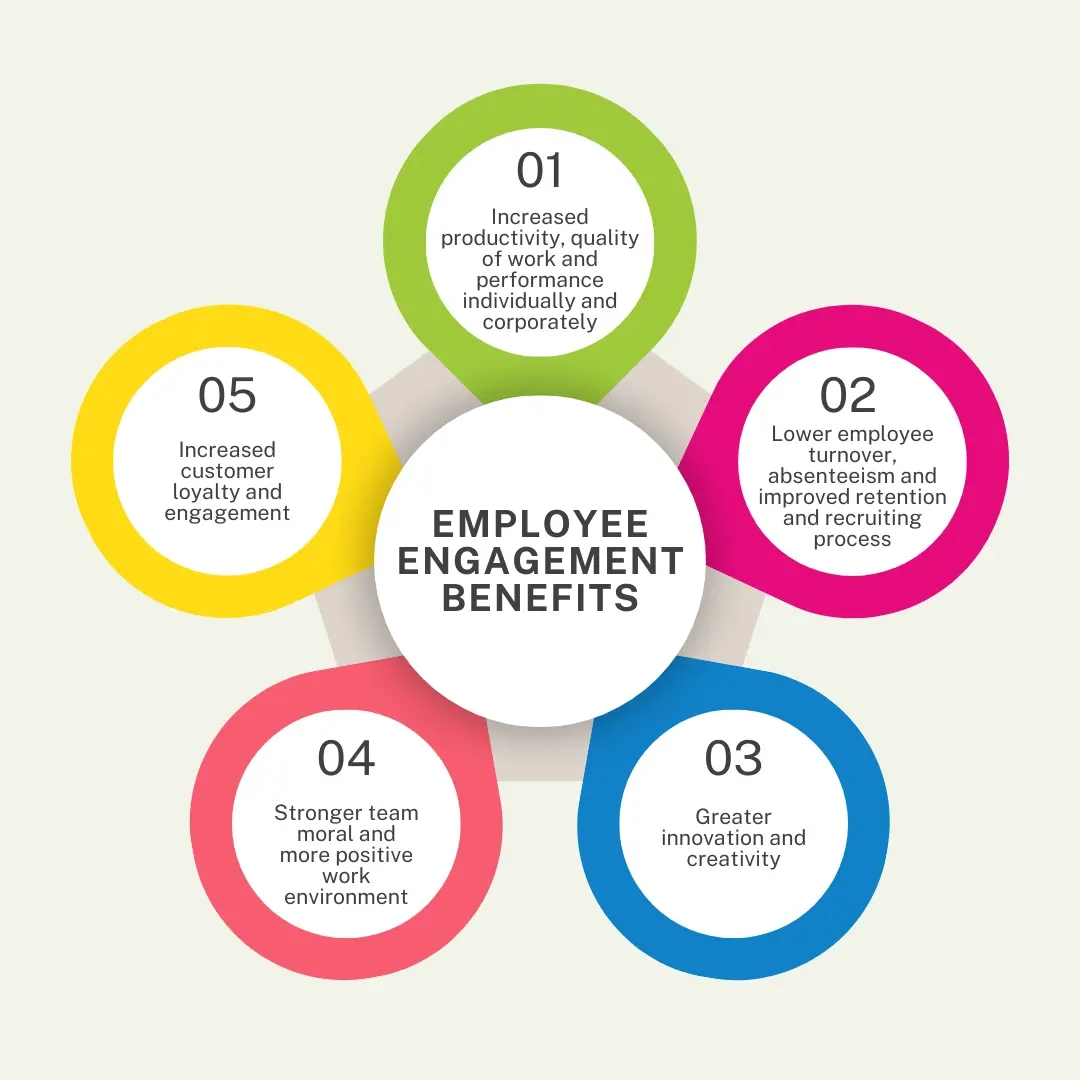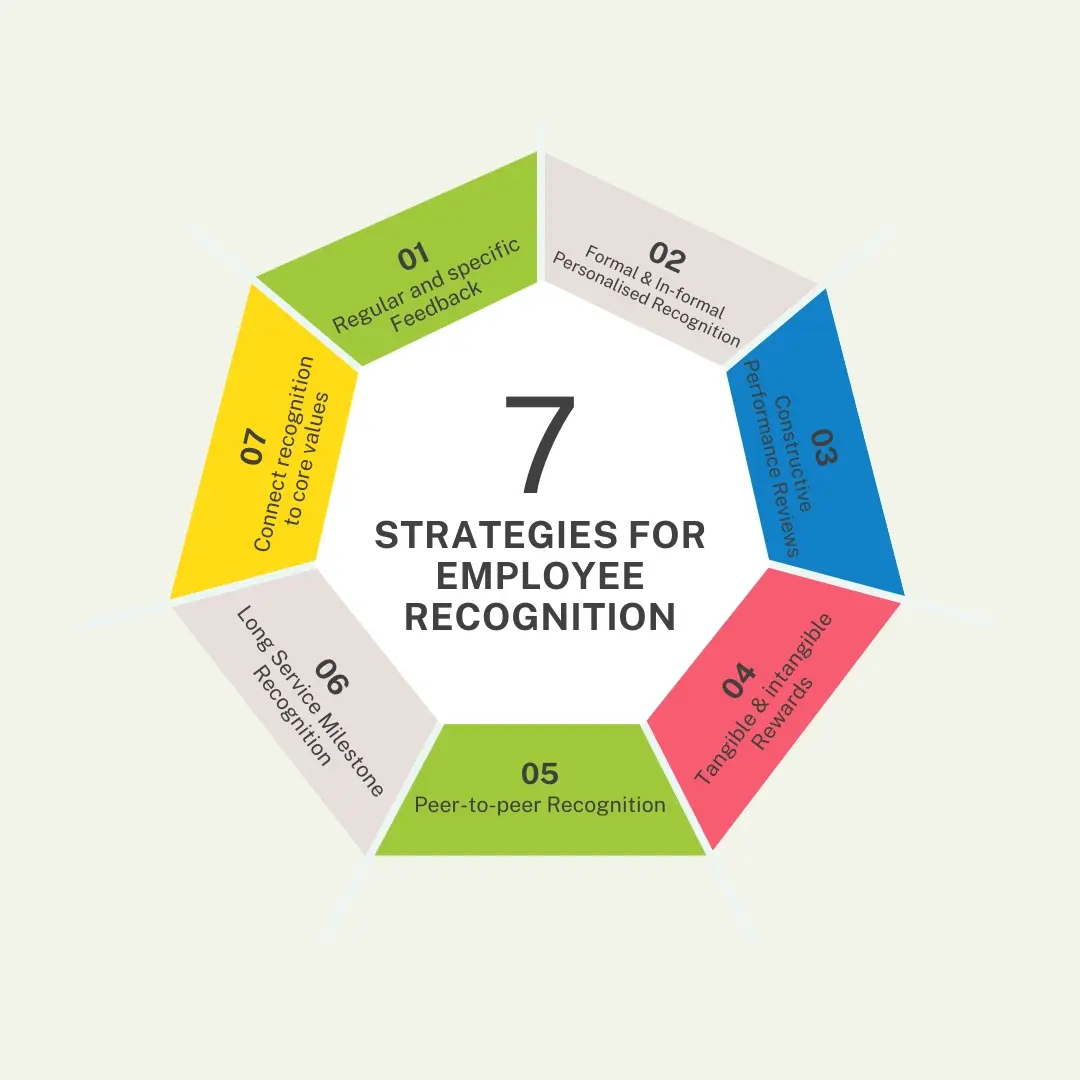Employee Engagement
Definition of Employee Engagement
Employee Engagement is a crucial concept that represents the level of commitment and enthusiasm employees have towards their work and their organisation. It extends beyond mere job satisfaction, reflecting how invested employees are in achieving the company's objectives and upholding its principles. An engaged employee is typically someone who says positive things about the organisation, intends to stay with it, and actively strives for its success.

Benefits of Employee Engagement

The benefits of a highly engaged workforce are substantial and far-reaching:
- Increased productivity and performance: Engaged employees are more likely to put in extra effort, leading to higher productivity. Gallup's research indicates a strong link between engagement and improved business outcomes, including potential increases in productivity.
- Lower employee turnover and improved retention: Engaged employees have a stronger desire to remain with their organisation. Low engagement is a significant predictor of employees intending to seek new employment.
- Better recruiting success: Organisations known for high employee engagement often attract more high-quality job candidates.
- Higher financial performance: Engaged workforces can contribute to better financial results, including higher earnings per share and profitability.
- Increased customer loyalty and engagement: Engaged employees are more likely to positively influence customer relationships.
- Greater innovation and creativity: Employees who are engaged are more invested in finding innovative solutions and improvements.
- Reduced absenteeism and safety incidents: Disengaged employees experience higher rates of absenteeism and are more prone to accidents.
- Improved quality of work: Engagement fosters a sense of ownership and commitment to producing high-quality work.
- Stronger team morale and a more positive work environment: High engagement contributes to a more positive and collaborative workplace culture.
Consequences of Employee Disengagement

Conversely, employee disengagement carries significant negative consequences:
- Substantial economic costs: Employee disengagement is estimated to cost the Australian economy billions of dollars annually.
- Reduced productivity: Disengaged employees often perform the minimum required, lacking the drive of engaged colleagues.
- Higher turnover rates: Disengaged employees are more likely to leave the organisation, leading to increased recruitment and training costs.
- Negative impact on company culture: Disengagement can create a negative atmosphere and undermine the morale of others.
- Increased stress and burnout: Feeling unvalued and disconnected from work can contribute to higher stress levels among disengaged employees.
- Higher rates of absenteeism and accidents: Disengaged employees are more likely to be absent and involved in workplace incidents.
- Lack of innovation: Disengaged employees are less likely to contribute new ideas or take initiative.

Employee Recognition as a Driver of Employee Engagement
Within the context of employee engagement, Employee Recognition emerges as a crucial driver and a powerful tool for improvement. Acknowledging and valuing employees' contributions is fundamental to fostering a more engaged workforce.
Employee Recognition plays a vital role in driving engagement by:
- Motivating employees: Recognition increases feelings of value and encourages continued high performance. Employees may strive to achieve further recognition for their efforts.
- Making employees feel valued: When their contributions are acknowledged, employees feel like integral parts of the organisation, leading to greater engagement.
- Highlighting the impact of contributions: Recognition often involves explaining the significance of an employee's achievements, reinforcing their understanding of their importance to the organisation.
- Addressing a key driver of disengagement: Lack of recognition can lead to feelings of being overlooked and undervalued, contributing to disengagement.
- Providing valuable feedback: Regular feedback, a form of recognition, helps employees understand their strengths and areas for improvement, contributing to their engagement and development.
Improving Employee Engagement through Employee Recognition

Organisations can implement various strategies for Employee Recognition:
- Providing regular and specific feedback: Offering timely praise for well-executed tasks and being responsive to employees' ideas and concerns. Continuous feedback models can enhance engagement.
- Implementing formal and informal recognition programs: Celebrating successes through team events, acknowledging individuals in meetings, and establishing staff awards. These can be done using an online recognition platform.
- Conducting constructive performance reviews: Using these as opportunities for positive reinforcement and development discussions.
- Offering tangible and intangible rewards: Providing financial incentives like bonuses or gifts of points for redemption, as well as non-monetary recognition such as public praise or special assignments. Non-cash rewards can have a significant impact, particularly for special milestones like long service recognition.
- Utilising peer-to-peer recognition platforms: Empowering colleagues to acknowledge each other's contributions, fostering a culture of appreciation. Platforms like HWH Engage facilitate this type of recognition.
- Personalising recognition: Tailoring acknowledgement to individual preferences and providing handwritten notes for a personal touch, either physcially or digitally through an online recognition platform.
- Connecting recognition to core values: Highlighting how an employee's actions align with and exemplify the organisation's values. In a good recognition platform, you can customise recognition criteria to match your corporate values.
- Recognising milestones: Celebrating significant career milestones, such as long service or retirement, with meaningful gifts and acknowledgements.

Conclusion
In conclusion, Employee Engagement is a fundamental element for achieving organisational success, with significant consequences arising from both engagement and disengagement. Employee Recognition is not simply a beneficial practice but a vital component in fostering a highly engaged workforce. By making employees feel valued, appreciated, and connected to the organisation's purpose through effective recognition strategies, organisations can cultivate a more productive, innovative, and loyal workforce, ultimately leading to improved business outcomes.
References
- Armstrong, P. (2023, September 12). Employee disengagement is costing the Australian economy $211 billion per year. HRM online.
- Australian Public Service Commission. (n.d.). Employee engagement.
- Comcare. (2024, November 4). Inadequate reward and recognition.
- Gallup. (2023, January 7). The benefits of employee engagement.
- Gallup. (n.d.). How to improve employee engagement in the workplace.
- H.W. Holdsworth Recognition and Rewards. (2025). HWH Benefits: Employee Benefits.
- H.W. Holdsworth Recognition and Rewards. (2025). HWH Complete Solution Brochure.
- H.W. Holdsworth Recognition and Rewards. (n.d.). HWH Engage: Employee Recognition Software.
- H.W. Holdsworth Recognition and Rewards. (n.d.). HWH EX Infographic.
- Indeed. (2025). What is Employee Reward and Recognition? (With Differences). Indeed.com Australia.
- Insync. (2024). 15 innovative employee engagement ideas for Australian workplaces in 2024.
- Management 3.0. (2022, April 14). Enhancing the employee experience with Management 3.0.
- Pelago. (2025). Rewards and recognition: HR terms explained.
- Randstad Australia. (2023, June 9). What impacts employee engagement?
- Safe Work Australia. (n.d.). Inadequate reward and recognition.
- SafeWork NSW. (2018, January 30). Recognition and reward minimising work-related stress: Tip sheet 10. NSW Government.
- South Australian Government. (2024, March 27). 2024-South-Australian-Public-Sector-Highlights-Report.pdf.
- Stein, D., Hobson, N., Jachimowicz, J. M., & Whillans, A. (2021, October 13). How companies can improve employee engagement right now. Harvard Business Review.
- Smith, T. (2024, June 20). What is employee engagement? Definition, strategies, and example. Investopedia.
- Victorian Public Sector Commission. (2020, October 8). Reward and recognition.
- Victorian Public Sector Commission. (2020, October 8). Staff survey on rewards.
- Victorian Public Sector Commission. (2020, October 8). Team awards ceremony.
- WorkSafe Victoria. (2025). Work-related stress – low recognition and reward.
- Witt, C. (2023, June 2). Employee engagement is more than a plus, it’s essential. Forbes Business Council.
